 |
surfresearch.com.au
simon
anderson : a decade of design, 1981 |
| home | catalogue | history | references | appendix |
|
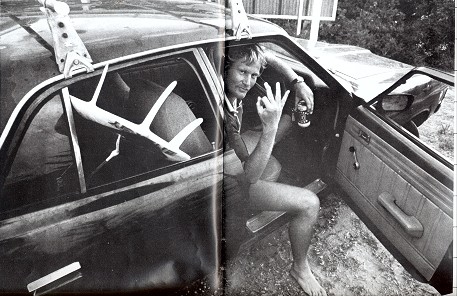 1.
1.
SW: Why did you start shaping?
Simon: Why don't you ask me a sensible question?
SW: Well there 's got to be a reason?
Simon: Alright then, why did I start
shaping? Hmmm. Well I left school in fourth form, I wasn't into any trade
or that sort of thing, so it just seemed like the logical step for me to
take. I was working in a surfboard shop fixing dings and the best job in
the factory seemed to be shaping surfboards.
When I started there Ijust wanted
to go surfing and the best way to get plenty oftimem the surf was to work
in a surfboard factory and I guess it was an ...what's the word for it
...an elite sort of job. When I was sixteen, everyone wanted to work in
a surfboard factory, so I guess that's one reason why I wanted to work
there, just so I could say I did. After I'd been there a while I started
to do okay in the contests and Shane, who I was working for at the time,
said 'What do you want to do, do you want to glass or shape?' And because
shaping was the ultimate job I thought, 'Hello, I'll be a big name here,
I'll get into the shaping bay and start hacking away'.
S W: When did you start designing as opposed to shaping?
Simon: You start designing your own boards straight off. I was fortunate because I started working on popouts (Shane Standard) which taught me how to use the tools. Then I did my first board when I could use the tools properly and I think I tried something new straight off. So I think design comes into it straight away, your mind starts ticking over as to what you can do.
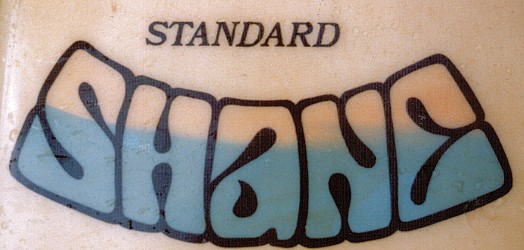
Simon: I think that's too hard a question for me to answer? (Laughs)
S W: Who showed you the rudiments of shaping?
Simon: When I was working down at Shane's (Surfboards) Terry Fitzgerald was there and Frank Latta. I think Terry was there before Frank came so Terry showed me the basics. Terry was the top shaper at the place, and Ted Spencer was the top surfer ...
S W: As opposed to 'shaper'? (Laughs)
Simon: Yeah, Ted used to come in and shape a few funny looking things ...but Terry was the head shaper there so he showed me the basics and he was pretty busy then so he didn't really have the time to spare. Then when Frank Latta came in I became friends with him and he showed me a lot, he showed me the shortcuts anyway. (Laughs)
SW: Fast Frank! Did anyone try to discourage you from actually designing boards?
Simon: No. A few people did try to impress upon me their idea of what was good and what wasn't
|
S W: But no one wanted you to just be a production shaper, popping them out? Simon: Well I did become a production shaper at one stage. SW: Was that at Shane's? Simon: Yeah. SW: How many boards would that entail? |
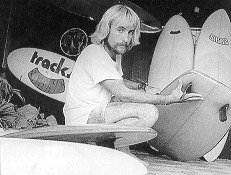 2.
2. |
Simon: Entail? Is that a fishing term? Well ...I think mass production is when you start doing twenty a week. It's just circumstance too, if you're only doing ten a week - well I consider thaI a lot of boards now, because I'm lazy - if you're doing ten you can spend a lot of time on them, but if you're doing twenty you can't really spend time on them so that's when it becomes mass production. You still get your basic idea into the board but the bumps and stuff are there however you don't bother about them. That's what production shaping is. I don't realiythink that it does all that much harm, it's just that another shaper could tell that they aren't as good as they should be.
S W: Do you reckon the artform in shaping is a fallacy?
Simon: You'd better break out the joints. (Laughs)
SW: Do you think it's an art, or is it more like a trade? Do you think all that artform stuff is a load of shit?
Simon: Umm, well, in some cases I
think it's a load of shit, but the way I approach the design
of a surfboard is by appearance.
If I don't like the look of it then I don't like the board. So in that
case it's an artform I guess because the board's got to be pleasing to
the eye for me otherwise I don't think it's any good. And usually it doesn't
work any good if it hasn't got the correct line through the deck or the
bottom or whatever. So in that way I think it's an artform. But if you're
mass producing them, doing twenty a week, or even fifteen, then it's not
an artform.
SW: It's more like a trade?
Simon: It's just a circumstance where
the boss says you've got to do this many and you can't just sit there and
look at every finished blank and go 'Ohh, this board looks great, this
is really ART', you've just got to pop 'em out.
So in some senses it can be an artform,
but I think it only applies to me. (Laughs) No, I suppose it is an artform
because anyone who looks at their boards must have a certain amount of
pride in them, they must consider them an artform to themselves. Like I
can look at other people's boards and I wouldn't consider them artform
but I look at some of mine when I've got the pressure on and I don't consider
them artforms either. I shouldn't say that - Scrub that! Sometimes the
pressure is on me when I've got to do a few boards and I will leave some
bumps in them because I haven't got the time to really sit down and take
them out. They still work alright, they've still got a good look about
them.
SW: How does the idea for a new design come to you? Does it come in various ways or just the one?
Simon: In my case, I've just been working on the one design principle for a while and I've changed little bits here and there. The way that comes about is that I'll surf the board I'm riding at the present and if I feel it's not giving me some little thing here or there I'll figure out what could do that, what could give me that little bit extra, and I'll try to put it into the next board I shape myself. It's just a board to board thing, more or less a gradual evolution, unless an outside influence has been directed at me.
SW: How often does that happen?
Simon: Well I didn't think it ever would. Actually, I tell a lie there because the track I'm on is what I consider to be a completely foiled surfboard, other people have got different ideas on what a foil is. To to start with, I got onto this foil idea from David Treloar, it was born on the north coast of NSW and I dragged it down to the city. That's where I got my first direction, from David Treloar's pintailed foiled surfboard and I've been working on that principle ever since. I wasn't worried, but I didn't think I'd be influenced by anyone else maybe because of a slight ego trip or something, however the second influence that I've had was from Geoff McCoy with his pointy nose.
S W: We'll come back to that later on. Is it hard to come up with a design that somebody at some time hasn't done before? Like someone who might claim they did the same thing in 1958 or something?
Simon: I suppose it is in a way. If you studied every surfing magazine with a design article throughout the history of surfing I suppose it would be pretty hard to come up with an original idea but I think if something comes into your head and you create it, although someone else has done it before, if you perfect it then it can be considered your achievement. But it is hard to come up with something new because we're running out o:f variables at this stage.
S W: Do you think there's a temptation for a designer to do something outrageous for purely publicity purposes?
Simon: When you create something new, you have this in the back of your mind anyway. I'm continually laying awake at night on occasions thinking of new ideas or particular ideas that might work. You've got to think about the commercial aspect of it too.
SW: Do you think there'd be people who might design a board that they knew probably wasn't functionally that good but of which they might be able to flog a lot?
Simon: I don't really think so, maybe that could be true, but basically whatever you make is going to work anyway, and if you sell a lot because it's new... like, I think a lot gets around by word of mouth, so if you're selling a few the board must be working anyway, so Good Luck to them. Most things work and a lot of people like new things, but I think they should see someone surfing it well before they get it, if hey don't then it's just their fault. But if you can get away with it, why not? It happens in the business world in different ways to that all the time. A few people up in Byron mightn't like it but it happens.
S W: Are you proud of the fact that riders for rival makers come and ask your advice on design?
Simon: Who said they do?
S W: We just know they have over the years, especially to do with big wave design, do you think it shows they've got a lot of respect for you?
Simon: I don't know, I think it probably
shows that they don't know about some particular aspect that I might know
about -specifically the big wave thing, because I know I had to ask a lot
of people about boards for big waves before I knew what was happening with
them.
I think it's good that someone might
recognise that you've got experience in these things.
The first time I went to Hawaii,
I asked people and then I considered what they'd told me, then I shaped
what I felt was right.
The trouble I had in the first couple
of years was that I'd be shaping all these boards for Sydney, trying to
make loose boards, doing six footers by 20" wide, then all of a sudden
I'd do an eight foot long board for Sunset and I couldn't get a perspective
on how they should be. A lot of the time I didn't have enough bottom curve
and they were too wide in the tail, too much area throughout really.
It wasn't until I made boards over
there that I succeeded in making a board that worked for Hawaii, for bigger
waves anyway. And it wasn't until I brought a board back from Hawaii that
I was able to make boards from here that worked over there.
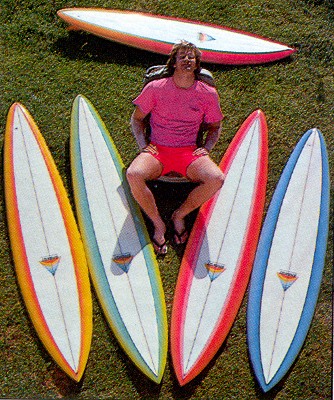 3.
3.Simon: When I first started I tried
various things and a lot of the time I found they didn't work. I didn't
know much, but that's how you've got to start I guess. Then I finally got
a direction which I could work on. It's a funny thing, when I first started
I made this foil board like the boards I was going to ride later on, except
it wasn't very well shaped and it was a bit short for me, plus it probably
didn't have good rails. But it was a foil board, completely against what
everyone else was making. It didn't work because it didn't have the right
flotation and all that sort of stuff.
So I went off them for a year or
so and then foils did come in in a big way. I got onto one up at Angourie
and that's when I started to work on them. It's been a case ever since
of refining that foil idea to suit myself initially and then in the end
to suit the average surfer, which was a harder thing for me to do.
The reason it was harder was because
I'm about 14 stone, I drift up to about 14 1/2 - 15 sometimes, and the
average guy is around 12 stone or less. So it's pretty hard for me to relate
to what's going to be effective for a person of that weight.
S W: Does having pretty good young surfers riding your designs help you there?
Simon: Yeah, that's how I get feedback on that problem, by having a closer relationship with guys around the normal weight level, that's come about in the last few years and it's helped me a lot.
S W: Over the last couple of years your natural progression has probably been altered a little bit probably because you've needed competition-wise to have a more manoeuvrable board in little waves ...
Simon: Yes. That's correct. That's
what started getting my mind ticking again. I was having a lot
of trouble surfing in contests in
small conditions, which most of them are held in. I've been trying for
a long time to get a board that was real good in small waves and still
had the feeling that I wanted. I tried thick boards, but I didn't like
them, I couldn't get them to work.
| S W: The first
design you tried for that purpose was twinfins wasn 't it?
Simon: Yeah, I tried going onto twinfins
- a desperate measure, I was a desperate man
SW: Were there any other drawbacks with twinfins? Simon: That was the major one, I think if you're on twinfins you've got to be totally on them, you're on them or off them. |
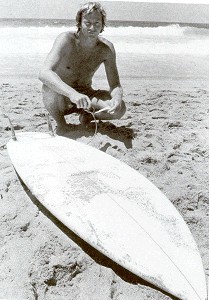 4.
4. |
Simon: No, not really, I just played
around with thickness and width while still keeping my
basics in there. I hadn't really
borrowed anything. (Pause) Maybe that was my mistake. (Laughs)
S W: The obvious thing you borrowed after that was that no nose design (called the Lazor Zap by McCoy/Horan). That came after you tried out twinfins didn't it?
Simon: Yeah. I'd gone onto the twinfins
because they were obviously surfing well in small conditions, but I didn't
want to ride them exclusively so I had to find another solution. Then Geoff
(McCoy) brought out his pointy nose model with the dome under the fin,
it's sort of hard to explain, I couldn't really grasp it when he explained
it to me. I saw Cheyne Horan, Mark Warren and Larry Blair and they
seemed to be getting a lot of drive
and manoeuvrability, so I had a go of Mark's board, his 5'IO",and it felt
quite fast and definitely loose. That's when I decided to make one of my
own.
I intended to make one with a dome
in it but I found that was a lot of hard work so I did a rolled Vee which
meant that it was basically the same shape. The dome is very hard to describe,
but it domes both longways and sideways, my rolled Vees do sort of the
same thing.
Geoff explained the theory of them
to me, I listened to that then I went away and put in my own ideas, which
were stimulated by him I guess.
S W: You developed it for your own needs, is that what you mean?
Simon: No, that's not what I mean.
I mean that I still left all my basics in there but I changed the bottom
shape from what he was doing, he had a lot more bottom curve and I widened
the tail out. Where he had double flyers and a swallow tail I had the single
flyer with the square tail to keep all the area up the back. And I had
the Vee instead of the dome because it was easier to shape. I had the edge
underneath the rail, which was good because it added a little extra area
to the bottom of the board and because you had the pointy nose it couldn't
catch up the front so you could keep the edge right through. Also I left
my basic thickness distribution, which is foiled, and I had my own rails.
Actually, I made the first board
in that style for Mike Newling because he was in a contest at
the time and, like me, he was having
trouble in small waves. This was the Lightning Bolt Trials,
and he got on that at Narrabeen
in small waves and he managed to get through to the main contest. It worked
well for him.
S W: Do you think Geoff thought up the idea from scratch or do you think he got an influence from somewhere else?
Simon: Well he got feedback from Cheyne, it was Cheyne's idea originally and Geoff developed it from there.
S W: Well that sort of confirms what
a lot of people say, which is that Cheyne got it of Brad Mayes
because evidently he 's had one for
untold.
Simon: Ah well, whatever. As far as I know it was a combination of Cheyne and Geoff. I don't think Cheyne could come in and design it all.
SW: If Cheyne did borrow anything from Brad it would have probably just been the planshape ...
Simon: Well Ted Spencer was doing a thing like that ages ago...
S W: Well there were the pig boards ages before that even.
Simon: If you can get ideas from
other people and come up with your own particular thing,
I then I think it's fair enough
to say it's yours.
S W: Do you think some designers don't
like to borrow ideas from other people because of their
pride?
Simon: That might come into it a little bit, I know I had a little bit of reluctance when I first started making them, when I first brought Mike's board down the beach because I knew it was ...well it was different in some ways, but it was the same as Geoff's. I was a little bit ...ah ... apprehensive about how people would react. Actually I was just worried that people might think I was directly copying this idea, which I was, but ...
S W: Well you didn't try to hide that fact, you said 'I copied Geoff 's one?'
Simon: Yeah. I suppose I was a bit worried because if I took it down the beach and it didn't work I'd look silly.
SW: Your no nose designs compared to
his seem ... a lot of good surfers on Geoff's when they first
started to ride them seemed to go off
the waves all the time, they seemed to have trouble with them at
first ...
Simon: Well l noticed that Cheyne in particular was really surfing well on them, I thought he was getting a lot of life out of the board. Cheyne's pretty powerful, even though he's small he's quite well built. I noticed later on, after seeing the average surfer in the water on a no nose board, that they couldn't handle it, they couldn't get the projection Cheyne was getting out of his turns. That was a problem. But I found with my designs that the average guy didn't have any trouble getting length out of the turn because it was different from Geoff's in certain ways which seemed to suit the average surfer, which was just perchance I guess.
S W: Okay, so why did you make a tri-fin?
Simon: I don't think we've really covered the single fin yet.
S W: Well, go back to where you want.
Simon: Well I started on that design.
I made Mike the first one and I left it a square tail to give it maximum
area in the tail. I thought that the extra width in the tail would compensate
for the extra bottom curve, and the Vee with a slight roll would give thrust,
which works the same as Geoff's boards really though I'm not too sure of
Geoff's total concept on his design. I found with the deep slight roll
Vee I was getting a lot of thrust throughout the turns and because of all
the bottom curve and Vee I was getting a board that was very manoeuvrable.
I found that instead of going in a straight line, I got more speed from
doing small turns, which is what the judges wanted anyway. This is why
in the first place I went onto this board, because I was looking for something
that was more manoeuvrable, that is, allowed more manoeuvres per wave than
what I had been doing.
My approach had always been to set
up the main section of the wave and do the maximum manoeuvre in that section.
Here I'd found a board that had speed and could do many manoeuvres. I wasn't
really sacrificing that good section I was just doing more manoeuvres to
get there. Though it was designed for contests it didn't worry me because
I still enjoyed surfing on it, it made surfing small waves more enjoyable.
I found I was doing a lot more stuff
on small waves than I had been and
I'd been more successful competitively using this design.
S W: It was like it added another dimension to your surfing?
Simon: To my small wave surfing,
for sure.
Now I've tried to adapt it into
bigger wave surfing because I think you've got to stick to the one general
design, you can't chop and change.
Although I did develop this for
contests, I feel it is a better board for the average customer (laughs)
because it is looser. Still, with my interpretation of Geoff's design,
you can draw out longer turns if you want to. This is where I feel it's
more successful than his is, or was then, I know he's done things to improve
his design for the general public.
Alright, I've finished with the
single fin now. We should be able to get about a paragraph out of all that
rubbish.
S W: The tri-fin. Was it something that just struck you one day? Or did you think about the ones that had been made before ? (see #211)
Simon: I was still worried about
small wave surfing, about the fact that even with this new design I wasn't
competitive with guys like Cheyne and Dane and Mark Richards and all those
blokes in small waves. I realise now that I never will be, but I'll come
closer.
So, I knew with twinfins you couldn't
step straight onto a single, so I thought I'd try to make a twin fin that
surfs like a single fin, so you can jump off the twin onto a single. Frank
Williams had a twinfin with a keel-like small single fin at the back, it
was only about an inch deep and he said that was a stabiliser. That's basically
where I got it from.
I thought I'd try to make a board
that had the speed through the turns of a twinfin but the stability of
a single, and the only way to do that was to make a twinfin with a single
fin stabiliser at the back. Where I differed from Frank was that I wanted
the single fin to be more dominant so I didn't make a low flat keel, I
added another fin.
I didn't change any aspects of my
pointy nose flyer square tail design, I just made it fractionally wider
in the tail and I cut down the area of the twin fins as well as moving
them forward a bit. Then I added a smaller single fin on the back.
Like I mentioned before, the way
I design things is by look, so I went around to Midget's and got them to
cut down some fins to what I thought looked right, then I stuck them on
the board where I thought they looked right. And miracle upon miracle,
it worked.
That first one which I made for
myself worked really well, it was very loose and fast. It was originally
designed for really small waves but I found that it was actually more suited
to the three to six foot range of surf. Then I made an even wider tri-fin,
which is the one in my car now, for smaller wave conditions and it was
an improvement. On this one I made the fins thinner, with less resin at
the bottom, and they were foiled better, because I had a problem with drag
in the first one, the first prototype (laughs).
This drag is caused by the number
of fins, that's why four or five fins would be out of the question, there'd
be too much drag. Even with three fins you're pushing it, but if they're
thin enough and well foiled, you can get away without any drag.
On the second one, I moved the fins
up another half inch, plus I moved the twinfins out due to the wider backed
board and the board's going really well.
S W: For a guy lighter than you, would it be harder for him to push it through turns?
Simon: Originally I thought that would happen because I was pushing my board hard and it felt sort of stiff to me, but the other day I was surfing it and I was pretty tired from doing production boards, (under his breath) don't buy any boards at the moment, and I was tired so I didn't want to put much effort into it. Despite this I found that the board was quite loose anyway. The harder you turn it the stiffer the board seems to be, if you don't put any pressure on it the board turns around easily anyway. In the meanwhile I've had a couple of lighter guys on them and they've said that they haven't had any problems with them.
S W: Would you call this board the end product, for the momen, of your design evolution, for want of a better word?
Simon: Ahhh ...yeah, it's getting pretty close. The thing is, every time that I think I've finally reached the end of the line I find a new direction. It's like I've just drunk what I think to be the last pub dry and I'm staggering home when I see another pub. So who knows?
S W: What do you think people see in you as a designer? Is it that you're no bullshit or what?
Simon: I don't know... as from a few weeks back they might think I'm innovotive (Laughs). No. I really don't know, I think the only way they can judge how a bloke's designs are going is by the way he's actually surfing the boards.
SW: So it's important for you to keep up your performances in the water?
Simon: Yeah. So long as people don't
expect too much from me on Sunday mornings.
So long as I'm getting the right
feeling out of my surfboards is the main thing. I like to get a lot of
speed and be able to put the board exactly where I want it to be. If that's
happening, well everything's happy.
SW: One of the faults of twinfins is often that they spin out, has this ever happened to you on the tri- fin?
Simon: Yeah, I've jumped it out of the water. I used to say that I couldn't spin it out, but you can. However, it is very hard to. I don't think I've really spun it out, just jumped it out. At the moment, what I've discovered after surfing the boards for a while is that you get the speed when you do turns through the twins. With the single fin stabiliser at the back, that is stabilising the speed, in other words, you're getting the speed throughout your turn rather than just a little whip turn. I've found that the board is actually the fastest board I've ever ridden, by a mile, and I'm doing the fastest, most radical cutbacks I've ever done.
S W: Do you think your boards have more all round appeal now, rather than just goin good in one situation?
Simon: Yeah. Well, when a customer comes in he always wants a board that's going to be really loose in two foot surf and hold in in ten foot surf - that's a basic request. I think to be a surfer nowadays you need a small wave board and a board designed for better conditions. Trying to drum up some sales (laughs). Still, I think this three finned design is more adaptable to all conditions than previous designs. It's stable on the backhand, whereas twinfins were unpredictable on the backhand.
S W: What sort of feelings do you get when a new design starts to show potential?
Simon: Well you get a certain excitement
about it that's quickly dampened by the cynics. People think that if you're
a good surfer you can ride anything, so they're a bit sceptical about any
new design that I might have, like the three fin, so naturally they're
sceptical. But I really have felt big improvements in the board in particular
areas. There are drawbacks, but the advantages more than outweigh them.
The drawbacks are that you haven't
quite got the same control on the backhand (laughs). The only spot where
that happens is off the top on the backhand, I can't put it exact/ywhere
I want it, but I don't think that would make much difference to the average
guy, it doesn't matter where he bounces off. I'm just having a little bit
of trouble on this now, but I'm sure that the longer I ride it, I'll just
adapt to it. I used to pull them straight up and that didn't work, now
I find that I can just lean into it, do a sort of full rail turn and the
speed will zoom it 'round, but sometimes I'm not quite hitting where I
want to. Sometimes, when it's smaller, you've got to pull it off after
a flick up, so I've just got to adapt to knowing when to do that and when
not to. But you get a fantastic feeling when you do a full rail bottom
turn and you've got a real lot of direction and speed off it.
S W: Would you like to just design boards and have someone else shape them?
Simon: No, because as I've said before, I don't work on dimensions, I don't work on measurements, I just work on the look of things most of the time. Very rarely do I measure a board in relation to another one, I just go on the actual look when I'm shaping it. I started measuring all the distances, the width 12" up, etc, I still test it now and again, but I did it for a while because I felt that I should be doing that but I've gone back to the look because there's so many variables in measurement that you may as well not bother about it.
S W: Do materials have much offect on the design of a surfboard?
Simon: Yeah. I think that the lighter a board is the better, but the trouble with that is that you make a real light board and it's not going to last too long. You've got to get a balance of lightness and strength, it's a delicate balance, one we're working on very hard down at Energy's (laughs). No, but you have a lot of trouble because sometimes you have a blank. that's going to suck in more resin than another one, so it's very much a pot luck thing.
S W: Is there anything you can 't do because of being restricted by the materials?
Simon: No. I'm just working with the materials I've got, that's all you can do.
S W: Do you think if anyone came up with revolutionary new materials that surfboard design would change radically?
Simon: That's the only way it can happen at the moment, we've gone about as far as we can go... because you can't go any further than three fins, I've finished off the cycle (laughs), Geoff's gonna pack up his bags and move into another business.
S W: Why hasn't design changed radicaliy for quite a while?
Simon: There's been a lot of changes I think, they haven't been radical changes because there's no more to be made ...maybe there is but ...the changes have been more subtle and the consumer doesn't recognise them so much, such as in the things I'm doing now and the things Geoff has done. I think they are radical changes, so in answer to your question, there have been radical changes.
S W: Do you think there will be many more in the future?
Simon: I can't envisage them now, I'm still wrapped up in my very futuristic three fin design of the moment. (Laughs) No, but as far as fins go, I don't think there can be any more than three, there might be little small fins stuck on the side of the rails or something, but as far as major fins go, because of the drag factor, three's the maximum.
S W: Are the fins the most important part of that design?
Simon: Well it's just my normal basic design so therefore I think that the fins are the most important part of that design.
S W: Do you think you've made a worthwhile contribution to surfboard design ?
Simon: I don't give a stuff whether I have or not, I've just done it to suit me, that's my answer. No, I'll add something else -Yes I have, but only my customers can appreciate it!
S W: Ahh. what humility.
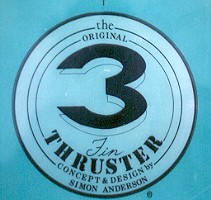
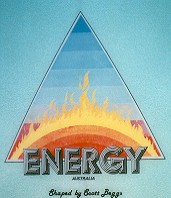 |
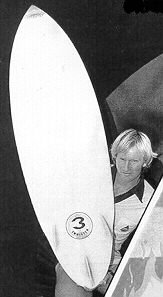 6. 6. |
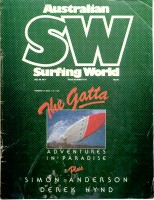
2. Shane
Steadman and Twin Fin 1, 1970
Cropped from reprinted ad, Deep
magazine Vol 4 #4 Winter 1999 page 52.
3. Simon Anderson and Hawaiian Quiver,
Winter 1977.
Surfing World Magazine, Volume
30 Number 1 page 28
Photograph by Aintionn
4. Simon Anderson and Twin-fin, 1979
Surfing World Magazine Volume
30 Number 1 May ? 1981, pages 23.
Photograph : Channon.
6. Simon Anderson and Thruster, 1981
Image right cropped from Ad : "The
Original 3 Fin Thruster ",
Surfing World Magazine Vol
30 # 2 1981.
| 2. For an early account of design
history, See
Dick Levine and/orShane Steadman and/orTerry Fitzgerald : Surfboard Designs Modern World magazine July 1971 pages 30 - 37. Editor: Dick Levine Simon Anderson, Spoon and Single fin featured on the cover. |

| home | catalogue | history | references | appendix |